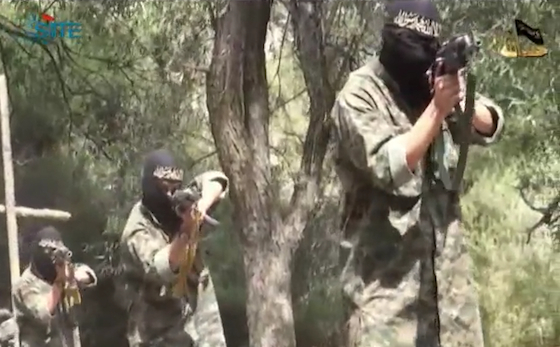|
|
|
Islamic Movement of Uzbekistan fighters train at a camp in Pakistan’s tribal agencies. Image from the SITE Intelligence Group. |
Afghanistan’s National Directorate of Security announced that it captured two operatives from the al Qaeda and Taliban-linked Islamic Movement of Uzbekistan during a raid in the capital city of Kabul. The fighters had trained in Pakistan’s Taliban-controlled tribal agency of North Waziristan and were involved in recent fighting in the remote northeastern Afghan province of Badakhshan.
The NDS announced today the capture of IMU operatives Fahim Jan, from Wardak province, and Ibadullah, from Parwan province, Pajhwok Afghan News reported. Khaama Press identified the two operatives as being members of the “Nahzat-i-Islami Uzbekistan.”
The NDS said the two IMU operatives had trained for 40 days in the Mir Ali and Miramshah areas of Pakistan’s North Waziristan tribal agency, and that they then fought in the Wardoj district of Badakhshan prior to entering Kabul. It is unclear if the IMU operatives were in Kabul to conduct attacks.
The Islamic Movement of Uzbekistan is a key ally of al Qaeda and the Taliban, and has been involved in supporting their operations in Afghanistan and Pakistan and plotting attacks in Europe. The IMU is known to fight alongside the Taliban in Afghanistan and has integrated into the Taliban’s shadow government in the north [for more information on the Islamic Movement of Uzbekistan, see LWJ report, IMU cleric urges Pakistanis to continue sheltering jihadis in Waziristan].
The IMU is known to use Pakistan’s tribal areas to train for attacks in both Afghanistan and Pakistan. On Oct. 27, the IMU released yet another video, “the 12th episode in its ‘What’s Happening in the Tribal Areas’ series,” the SITE Intelligence Group reported on Nov. 5.
“Footage shows IMU leader Uthman [or Usman] Ghazi leading the men in weapons training, and includes scenes of fighters rappelling down buildings, practicing raids and martial arts takedowns, and mounting horses,” SITE noted.
IMU emir Ghazi was named to lead the group in August 2012 after his predecessor, Abu Usman Adil, was killed in a drone strike on April 29, 2012 in Miramshah, North Waziristan.
IMU, Taliban, and Haqqani Network step up attacks in Badakhshan
The once-peaceful province of Badakhshan has become increasingly unstable over the past several years, as the Taliban, the Haqqani Network, and the Islamic Movement of Uzbekistan have exerted their influence in the remote northeastern area. The province was transferred from ISAF to Afghan control at the end of January 2012.
Most recently, in mid-September, jihadists in Badakhshan killed 21 Afghan policemen and captured another 24 after ambushing them in Wardoj. The ambush in Wardoj occurred just after the Afghan military and the International Security Assistance Force touted the success of Operation Hindu Kush, a nine-day operation that ended on Sept. 14.
ISAF is known to have conducted eight raids against the IMU in Badakhshan between September 2011 and June 2012, and another in August 2010 that targeted a Taliban operative who aided “foreign fighters,” according to ISAF press releases compiled by The Long War Journal. The last reported operation against the IMU in the northern province took place on June 18, 2012; an IMU commander was killed and several fighters were captured. The presence of the IMU has been noted in the districts of Argo, Faizabad, Kishim, Shahr-e-Buzurg, Surkh Rod, and Yaftal-e Sufla. In June this year, ISAF ceased issuing daily operational reports that detailed raids against al Qaeda and allied groups such as the IMU.










1 Comment
Why does the Pak army leave North Waziristan alone?
Too many assets?